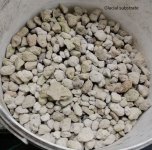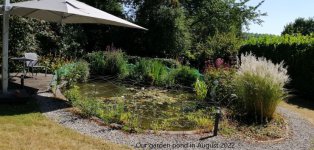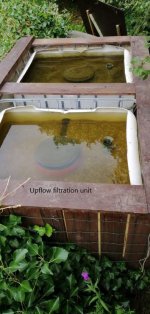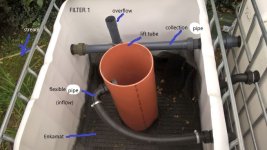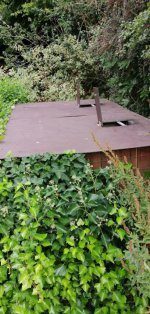- Joined
- Jul 29, 2022
- Messages
- 4
- Reaction score
- 6
- Location
- East Flanders
- Hardiness Zone
- 7 - 9 (USDA)
- Country

Our garden pond, built in 2007, was equipped with a ‘partition’ bog filter within the pond, reflecting 20 – 30 % of the total pond surface and separated by a porous retaining wall, the top of which is about 10 cm (3.94 “) below the pond surface. The helophytes grew with their roots in 8/16 mm lava stones and formed a mass of leaves above the water.
The pond has an EPDM liner, gently sloping banks and - in the main pond only - flat shelves at 4 depths to suit different planted baskets, a volume of 16,000 litres (4224 US gallons), depth of 1 m (3.281 ft) in the middle.
An air pump is used in sultry weather and during the winter in periods of frost, to keep openings in the ice, allowing toxic gases to be released.
So as to prevent blue herons from decimating the fish population, we have stretched 1.60 mm thick transparent nylon lines around and criss-cross over the pond at different heights.
During the fall a fine mesh net is put over the pond, to prevent leaves and other debris from entering the pond. I’m aware that all these measures take away from the natural look of our pond!
Fish: goldfish (+ goldfish breed, Sarasa comet), ide (golden, blue, silver orfe), rudd, tench, gudgeon
Aquatic plants: bog bean, hedgehyssop, broadleaf arrowhead, water mint, powdery alligator, grassy arrowhead, pickerelweed, moneywort, water lilies, fish mint, chameleon plant, Japanese variegated iris, lakeshore bulrush, marsh marigold, water buttercup, yellow flag, great manna grass, water primrose, purple loosestrife, watercress, water soldiers, Canadian waterweed, curly pondweed.
Unfortunately the initial ‘downflow’ bog filter had lost its filtering ability by 2017, due to a torn and clogged flexible drainage pipe, and it was replaced by a home-made ‘upflow’ biomechanical filtration system using glacial substrate as filter medium, with an outflow via a small stream.
The initial bog area was transformed into a zone with aquatic plants in pots with holes or slits near the bottom and filled with lava substrate. Underwater plants are grown within 50 mm (19.69 inches) high plastic fencing with holes too small for fish to pass through, thus also preventing plants from being sucked up by the pond pump.
Description of our present DIY filtration system:
The new filtration system for our pond consists of 2 IBC's (Intermediate Bulk Containers) of 1,000 liters (275 US gallons) each, the tops of which have been cut off. As referred to above, glacial substrate is used as filter medium.
On top: removable 4mm thick weather and moisture proof concrete plex (plywood) sheets with hatches for overflow monitoring and aeration purposes, and during winter XPS insulation sheets underneath, so that the filters can continue to operate safely in frost periods.
The filter cover plates keep the filters free of blossoms, leaves, berries, etc. from surrounding trees, avoid the forming of string algae (caused by exposure to sunlight) and ensure a favourable (dark) environment for beneficial (nitrifying) bacteria colonizing the filter medium.
Around: XPS insulation boards and impregnated wooden planks.
At the bottom of the containers, a sturdy galvanized metal grid, with a hole in the center for holding a 31 cm (12.20 “) diameter lift tube (ordinary sewage pipe) with access lid, rests on ± 20 cm (7.87 “) high concrete blocks, so that a void space beneath has been created. The grid is covered with a porous, 3D polyamide mat with an open structure (Enkamat trademark), and suitable for supporting the glacial substrate.
The pond water is pushed by the pump to both filters via a rigid PVC pipe connected to a spiral PVC pipe outside of the pond, at the end of which is attached a Y-piece, to which 2 flexible pipes are connected, which end up in the lift tubes in both containers. At the bottom of these lift tubes 3 crescent-shaped notches have been made, so that the water from the void space under the grid is pushed upwards in the tubes and through the polyamide mat around the tubes.
Due to its porous, woven texture, this mat guarantees a steady flow of the pond water to the filters and serves as some sort of 'pre-filter' that retains coarse particles from the pond in the void space under the grids (mechanical filtration). At the same time it serves as a surface on which also beneficial bacteria live.
The water moves up through the glacial substrate, in which a growing bacterial colony breaks down harmful substances from the pond and converts them into less dangerous and useful substances, such as CO2, which are absorbed by the plants as food (biological filtration).
As the glacial substrate becomes saturated, depending on the bio-load (amount of organic waste generated in the pond), a growing layer of clumping fine particles of organic waste (mulm) and bacteria forms in the water column on top of the substrate.
By way of 'overflow’ pipes in each container, which protrude ± 12 cm (4.72 “) above the substrate, and which are connected perpendicularly to a lower, horizontally fitted 'collection pipe', the filtered water exits and returns to the pond via a ± 4 m (4.37 yards) long stream.
The pond water is sucked in by a Messner MultiSystem MPF 10000 submersible pond pump 135 Watt, with removable pre-filters, maximum pump capacity (volume flow rate) of 9900 liters (2615.30 US gallons) per hour (165 liters = 43.59 US gallons = per minute), a Vortex impeller that allows dirt to pass through up to 6 mm (0.24 “) grain size and a thermal overload protection. This pump is positioned in the pond, as far as possible from the outflow of the filters, at a frost-free depth, and runs continuously.
As far as maintenance is concerned, taking into account the large fish load and the associated organic load on the pond, each filter is flushed from above, about every 3 months for the time being.
In order not to damage the entire bacterial colony in the filtration system, both filters are not cleaned at the same time, and always pond water, or water from the rainwater well (in the event of a greatly reduced pond water level, due to evaporation), is used.
First, the pond pump is turned off, the valve at the back of the container is opened, and as soon as no more water leaves the valve, the glacial substrate is flushed from above using an available Gardena garden pump 3000/4 and garden hose. Finally the valve is closed again and the pond pump is switched on, so that the water supply to both filters can resume.
Our upflow filtration system has been functioning to our entire satisfaction so far.
I would appreciate reading about (preferably) experience-or science-based opinions from water gardeners about home-made filtration systems in general, and the use of glacial substrate or any other filter medium in particular, so as to learn from successes and mistakes, if any.
Thanks in advance!
Michel G
The pond has an EPDM liner, gently sloping banks and - in the main pond only - flat shelves at 4 depths to suit different planted baskets, a volume of 16,000 litres (4224 US gallons), depth of 1 m (3.281 ft) in the middle.
An air pump is used in sultry weather and during the winter in periods of frost, to keep openings in the ice, allowing toxic gases to be released.
So as to prevent blue herons from decimating the fish population, we have stretched 1.60 mm thick transparent nylon lines around and criss-cross over the pond at different heights.
During the fall a fine mesh net is put over the pond, to prevent leaves and other debris from entering the pond. I’m aware that all these measures take away from the natural look of our pond!
Fish: goldfish (+ goldfish breed, Sarasa comet), ide (golden, blue, silver orfe), rudd, tench, gudgeon
Aquatic plants: bog bean, hedgehyssop, broadleaf arrowhead, water mint, powdery alligator, grassy arrowhead, pickerelweed, moneywort, water lilies, fish mint, chameleon plant, Japanese variegated iris, lakeshore bulrush, marsh marigold, water buttercup, yellow flag, great manna grass, water primrose, purple loosestrife, watercress, water soldiers, Canadian waterweed, curly pondweed.
Unfortunately the initial ‘downflow’ bog filter had lost its filtering ability by 2017, due to a torn and clogged flexible drainage pipe, and it was replaced by a home-made ‘upflow’ biomechanical filtration system using glacial substrate as filter medium, with an outflow via a small stream.
The initial bog area was transformed into a zone with aquatic plants in pots with holes or slits near the bottom and filled with lava substrate. Underwater plants are grown within 50 mm (19.69 inches) high plastic fencing with holes too small for fish to pass through, thus also preventing plants from being sucked up by the pond pump.
Description of our present DIY filtration system:
The new filtration system for our pond consists of 2 IBC's (Intermediate Bulk Containers) of 1,000 liters (275 US gallons) each, the tops of which have been cut off. As referred to above, glacial substrate is used as filter medium.
On top: removable 4mm thick weather and moisture proof concrete plex (plywood) sheets with hatches for overflow monitoring and aeration purposes, and during winter XPS insulation sheets underneath, so that the filters can continue to operate safely in frost periods.
The filter cover plates keep the filters free of blossoms, leaves, berries, etc. from surrounding trees, avoid the forming of string algae (caused by exposure to sunlight) and ensure a favourable (dark) environment for beneficial (nitrifying) bacteria colonizing the filter medium.
Around: XPS insulation boards and impregnated wooden planks.
At the bottom of the containers, a sturdy galvanized metal grid, with a hole in the center for holding a 31 cm (12.20 “) diameter lift tube (ordinary sewage pipe) with access lid, rests on ± 20 cm (7.87 “) high concrete blocks, so that a void space beneath has been created. The grid is covered with a porous, 3D polyamide mat with an open structure (Enkamat trademark), and suitable for supporting the glacial substrate.
The pond water is pushed by the pump to both filters via a rigid PVC pipe connected to a spiral PVC pipe outside of the pond, at the end of which is attached a Y-piece, to which 2 flexible pipes are connected, which end up in the lift tubes in both containers. At the bottom of these lift tubes 3 crescent-shaped notches have been made, so that the water from the void space under the grid is pushed upwards in the tubes and through the polyamide mat around the tubes.
Due to its porous, woven texture, this mat guarantees a steady flow of the pond water to the filters and serves as some sort of 'pre-filter' that retains coarse particles from the pond in the void space under the grids (mechanical filtration). At the same time it serves as a surface on which also beneficial bacteria live.
The water moves up through the glacial substrate, in which a growing bacterial colony breaks down harmful substances from the pond and converts them into less dangerous and useful substances, such as CO2, which are absorbed by the plants as food (biological filtration).
As the glacial substrate becomes saturated, depending on the bio-load (amount of organic waste generated in the pond), a growing layer of clumping fine particles of organic waste (mulm) and bacteria forms in the water column on top of the substrate.
By way of 'overflow’ pipes in each container, which protrude ± 12 cm (4.72 “) above the substrate, and which are connected perpendicularly to a lower, horizontally fitted 'collection pipe', the filtered water exits and returns to the pond via a ± 4 m (4.37 yards) long stream.
The pond water is sucked in by a Messner MultiSystem MPF 10000 submersible pond pump 135 Watt, with removable pre-filters, maximum pump capacity (volume flow rate) of 9900 liters (2615.30 US gallons) per hour (165 liters = 43.59 US gallons = per minute), a Vortex impeller that allows dirt to pass through up to 6 mm (0.24 “) grain size and a thermal overload protection. This pump is positioned in the pond, as far as possible from the outflow of the filters, at a frost-free depth, and runs continuously.
As far as maintenance is concerned, taking into account the large fish load and the associated organic load on the pond, each filter is flushed from above, about every 3 months for the time being.
In order not to damage the entire bacterial colony in the filtration system, both filters are not cleaned at the same time, and always pond water, or water from the rainwater well (in the event of a greatly reduced pond water level, due to evaporation), is used.
First, the pond pump is turned off, the valve at the back of the container is opened, and as soon as no more water leaves the valve, the glacial substrate is flushed from above using an available Gardena garden pump 3000/4 and garden hose. Finally the valve is closed again and the pond pump is switched on, so that the water supply to both filters can resume.
Our upflow filtration system has been functioning to our entire satisfaction so far.
I would appreciate reading about (preferably) experience-or science-based opinions from water gardeners about home-made filtration systems in general, and the use of glacial substrate or any other filter medium in particular, so as to learn from successes and mistakes, if any.
Thanks in advance!
Michel G

